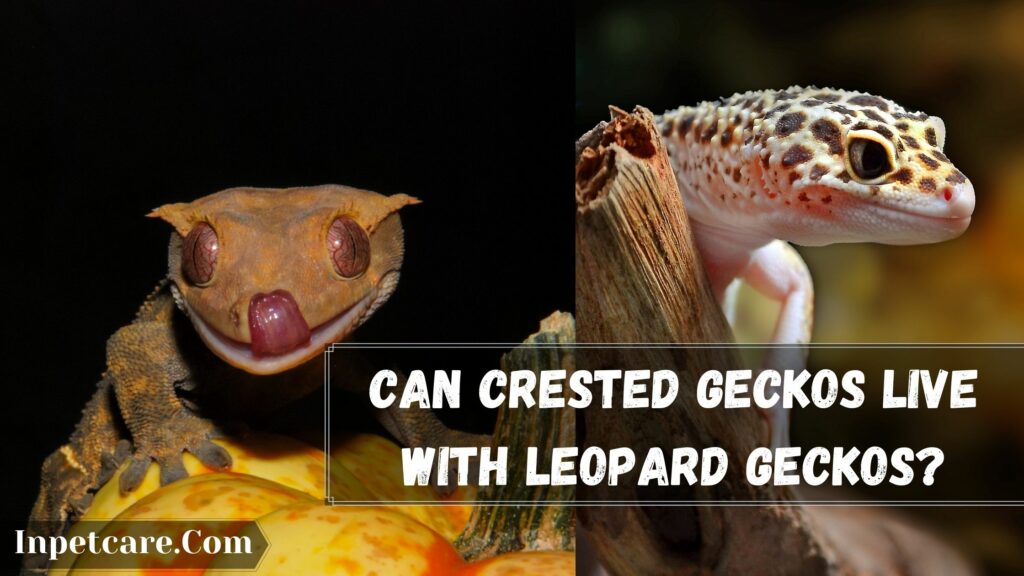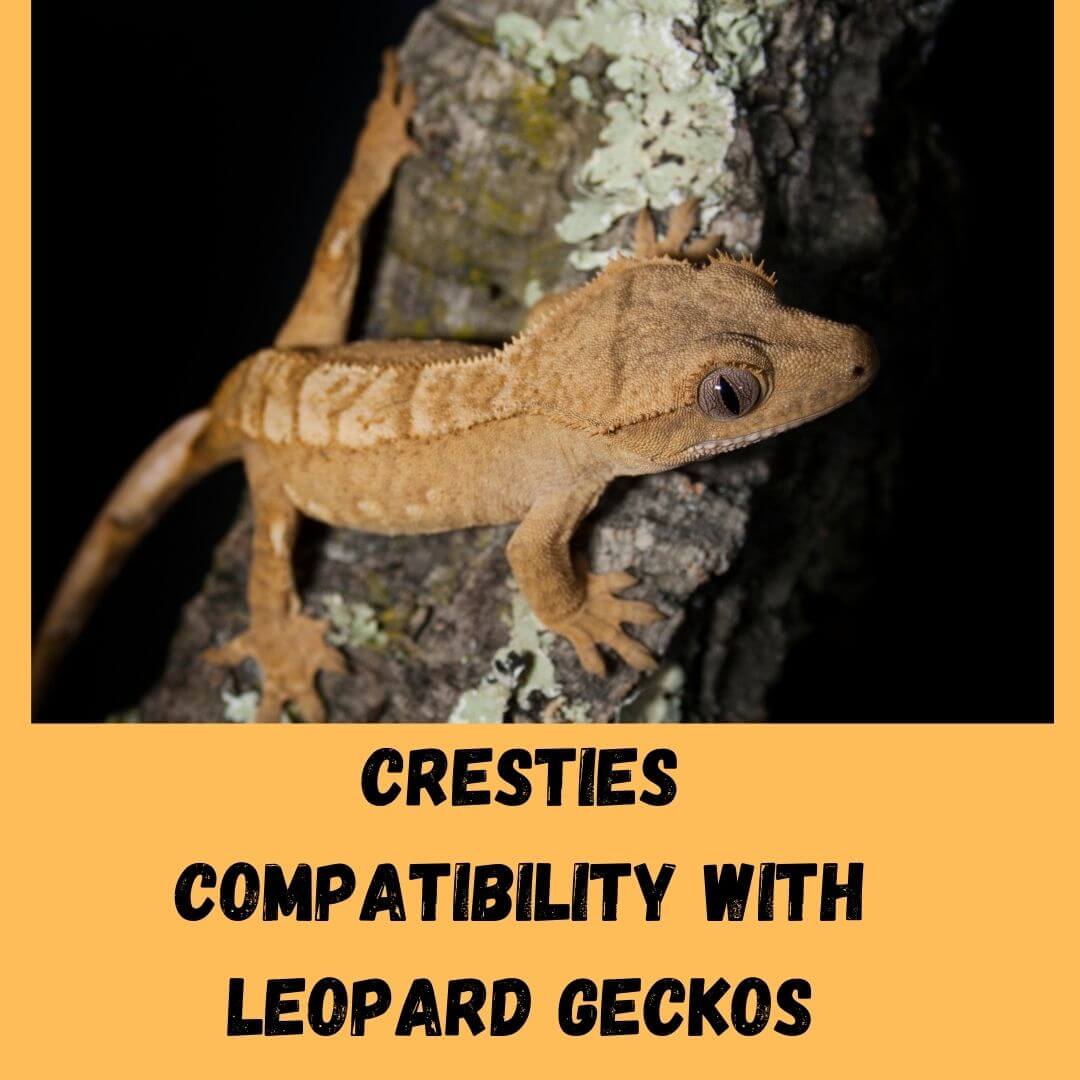Keeping Crested Gecko With Leopard Gecko: The crested and leopard geckos are two of the most famous reptiles you can keep for your pet. They’re gorgeous, and keeping them together could be on people’s minds. But can crested geckos be capable of living alongside leopard geckos?.
Don’t be fooled by telling yourself to try your best to be an internet sensation, but keeping crested and leopard geckos in the same enclosure will result in catastrophe for both species. If you’re struggling to believe it, I’ll explain why this can’t be done and why the results could be catastrophic.
Post Contents
Can Crested Geckos Live With Leopard Geckos?

As mentioned, crested geckos shouldn’t be kept in tanks with leopard geckos within a single tank, and they shouldn’t be kept within the same aquarium as the other geckos with crested backs. It doesn’t matter how big the tank is or what type of reptile they look like.
There will come a time when you’ll find yourself regretting keeping both kinds of fish in one tank. The reasons below explain why keeping Cresties and leos in the same tank isn’t possible. Because they’re both from different regions all over the world, the habitats, as well as their diet and susceptibility to temperature and humidity, are very different. The general rule is that reptiles from other regions shouldn’t be kept in the same enclosure.
4 Reasons To Avoid Keeping Crested Gecko With Leopard Gecko
Different requirements for housing
Crested geckos are native to Australia, and leopard geckos originate from Australia to Pakistan. Their housing needs differ, making it nearly impossible to determine how to make them adaptable to the specific species.
THE REQUIREMENTS OF crested geckoS
Crested geckos are found among the trees in New Caledonia and are arboreal, which means that they spend the majority all their lives in the forest and the surrounding foliage. Therefore, you won’t see the majority of crested geckos sleeping among the dry dirt. Crested geckos aren’t a fan of extreme temperatures but are more tolerant to the same temperature as humans.
They are more comfortable with temperatures in the high 70s (between 27 and 24 Celsius) Celsius) during times when they are awake and active. They’ll require lower temperatures in the evening when they’re asleep and not in a hurry. The next day, they’ll require temperatures in the 60s to 70s degrees Fahrenheit (20 up to 22° Celsius).
Crested geckos flourish in humid environments and require high humidity levels to remove skin and stay healthy. The ideal humidity range is 60 to 80 percent, but they may be able to tolerate more humid conditions as long as the terrarium is equipped with adequate ventilation.
The requirements of LEOPARD GECKOS
However, Leopard geckos are nocturnal and come from their hiding spots at the beginning of each day to search for food in the evening. They don’t require a lot of lighting sources, as the majority have their leopards without any lighting since the outside light is sufficient to simulate a day-to-night cycle in the habitat.
They use either a heat mat or a heating mat to provide a heat source. Can leopard geckos be kept in a group with crested geckos? While crested geckos require a heat source, leopard geckos prefer to heat their bodies on a hot stone or in caves heated by the sun or the heating lamp.
Leopard geckos require lower temperatures as compared to crested geckos. Since you’ll need an intense heat source for your crested gecko, it will be challenging to generate less temperature than the leopard gecko requires.
Additionally, certain species of leopard geckos have been experiencing problems with UVB lights.
There is a way to use UVB lighting for common leopard geckos. The leopards, which are albinos, can be a great illustration, and they might have issues with their eyes due to UVB lamps. If you’re looking to learn the temperatures and requirements for lighting leopard geckos need to meet to enjoy, read my guide to lighting for leopard geckos.
It is, however, possible to house both reptiles within one tank. The divergent requirements only create more challenges. The reasons listed below will help you pinpoint precisely where the problem begins.
Diet
Crested geckos are omnivores that consume insects and fruits in the wild. They’ll generally receive replacement food powders in captivity and sometimes insects or fruits occasionally, but they will treat them. Leopard geckos are primarily a consuming species of insects in their heart.
They also feed on crickets, mealworms, and waxworms in the enclosure. There are commercial diets available. But they’re not exactly like the ones offered by crested geckos. Of course, one can solve this problem by feeding them differently and using commercially available diets that cater to both species of geckos.
But most leopard gecko owners prefer feeding insects or crickets, which could be detrimental to the crested gecko. The crestie may get overweight, and you’ll have to control the diet that your crested gecko follows to ensure it is getting all the vital nutrients it needs.
Male Crested Geckos As Well As Leopard Geckos, Are Territorial
In terms of aggressiveness, male crested geckos tend to be very territorial and not keen on having invaders within their territory. The tank that you reside in is home to the crested gecko.
Male crested geckos usually exhibit aggression toward the other geckos with an erect heads. However, your crested gecko might think that a leopard is also an intruder and will kill the leopard.
But male leopard geckos can be territorial and don’t care how large the person invading their territory is. If they think they’re at risk within their environment, they’ll have the ability to take action.
Leopard geckos are cute and appear to be soft and welcoming. However, I’m confident when I say that they can cause significant damage to reptiles. If the crested gecko is asleep at night and your leopard notices it, the leopard could remove a portion or even all its feet and tail.
Interesting Further Reading
- Are Crested Geckos Good Pets? 5 Reasons Why?
- How Do Crested Geckos Sleep? 3 Important Places
- What Fruits Can Crested Geckos Eat? 13 Safe Fruits
BOTH PARASITES FOR CARRYING
Let’s assume that you guarantee us that there’s zero chance that anything could occur. Let’s say you’ve got an area large enough to provide the required space for the reptiles. It’s big enough that snakes don’t contact one another.
There are still problems with parasites. Crested geckos are natural carriers of parasites, and leopard geckos are also. However, crested geckos are afflicted with different parasites from leopard geckos. And while they are comfortable with parasites, leopard geckos don’t.
Reptiles all release parasites through their feces, and other reptiles can be infected with parasites after crawling around in their feces or walking close to them. The possibility that the crested gecko can transmit parasites, viruses, or bacteria to the leopard or vice versa is relatively high.
WHY IS IT SO HARD TO KEEP crested geckos WITH OTHER REPTILES?

Finding another species that you can keep within the crested gecko with no problems isn’t easy. There are several reptiles that you can save using the crested gecko. However, there’s no guarantee it will work.
I’ve written a complete article on the topic. If you’d like to know the reasons for this issue and what reptiles might be suitable for keeping with crested geckos, click here.
CONCLUSION
It’s clear that keeping crested and leopard geckos in a tank don’t appear to be logical. A few people have tried this and come up with a leopard that was dead. The leopard gecko wasn’t dead; it might have had its tail missing, or perhaps a single leg.
You might be tempted to keep these beautiful species together, but be careful not to do this. This is a significant error, and a separate tank to house the leopard shouldn’t be costly. So do crested geckos live alongside leopard geckos and coexist? Not!Any questions? Write to the comment section below!

94% of pet owners say their animal pal makes them smile more than once a day. In 2007, I realized that I was made for saving Animals. My father is a Vet, and I think every pet deserves one. I started this blog, “InPetCare”, in 2019 with my father to enlighten a wider audience.
